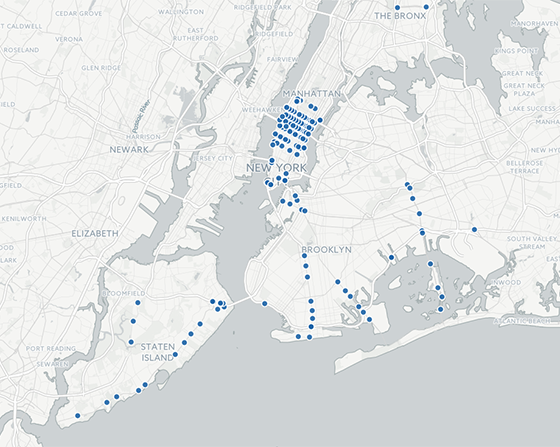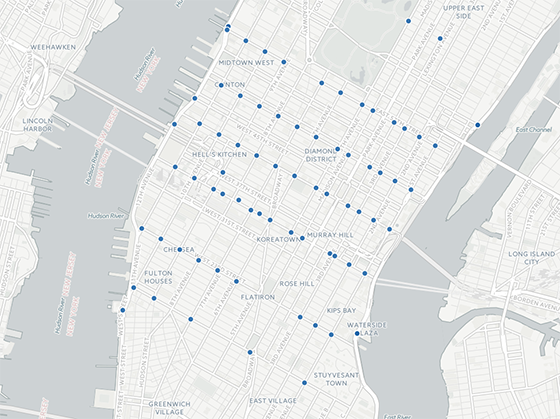Meeting the Moment: The 2024 Civil Rights Agenda for New York
Civil Liberties Union

In 2014, the NYCLU sent FOIL requests about E-ZPass readers to the New York City Department of Transportation, New York State Department of Transportation, New York State Thruway Authority and NYPD.
E-ZPass readers are devices that scan and read the electronic tags that drivers keep in their cars for the purpose of paying tolls through the E-ZPass system. By signing up for E-ZPass and keeping the tag in the car, drivers can pay their tolls electronically and avoid long lines at toll plazas.
News reports indicate that E-ZPass readers are used in locations across New York City where there were no toll booths. We got in touch with a privacy activist who had designed a cow-shaped device that mooed every time it detected signals on the same frequency that E-ZPass readers use. We took the cow out for a car ride in late 2013 and listened as the cow mooed its way through Midtown and Lower Manhattan – though we weren’t at any toll plazas, something was reading the E-ZPass in our car. In an area around 34th Street and Seventh Avenue, the cow mooed continuously for several blocks.
We were intrigued. We wanted to know why there appeared to be E-ZPass readers scanning people’s E-ZPass tags at locations far from any toll plazas.
Location of E-ZPass Readers in New York City*

Source: New York City Department of Transportation FOIL Production (July 11, 2014). New York State Department of Transportation FOIL Production (May 9, 2014). *NYS DOT production revealed seven E-ZPass readers within New York City; all were duplicative of E-ZPass reader locations revealed through NYC DOT production and are not distinguished visually here.
Location of E-ZPass Readers in Midtown Manhattan*

Source: New York City Department of Transportation FOIL Production (July 11, 2014). New York State Department of Transportation FOIL Production (May 9, 2014). *NYS DOT production revealed seven E-ZPass readers within New York City; all were duplicative of E-ZPass reader locations revealed through NYC DOT production and are not distinguished visually here.
Through FOIL responses, we learned that city and state transportation agencies have set up E-ZPass readers in various locations to conduct traffic studies. (The NYPD stated in its response that it does not operate E-ZPass readers.) According to a document produced by the city Department of Transportation, E-ZPass readers are a cost-effective way of “detecting segment travel times via matching reader observations at the ends of the segments, sending the raw data back to actually do the matches, and to generate the travel time observations.”1 The E-ZPass readers that we found during our test ride were likely part of Midtown in Motion, a technology-based traffic management system rolled out in 2011. Under this program, the city Department of Transportation initially installed 100 microwave sensors, 32 traffic video cameras and E-ZPass readers at 23 intersections to measure traffic volumes and congestion, and record vehicle travel times in the area between Second and Sixth avenues and 42nd to 57th streets.2 The program has since expanded. By August 2013, 43 E-ZPass readers were generating 250,000 records of completed travel time on a daily basis.3 By July 11, 2014, there were 149 E-ZPass readers around New York City.4
Yes. A traffic study is a laudable project, but adopting technology that allows for mass collection of individual vehicle trip time data is concerning when there are no appropriate privacy protections. The New York State Department of Transportation and the New York State Thruway Authority, for example, produced privacy policies that are vague and barebones. Those agencies report that the E-ZPass readers they use at non-toll locations work differently from those at toll locations. Part of a system called TRANSMIT, the readers electronically scramble identifying information about EZ-Pass accounts, assign an anonymous ID to each vehicle that passes through the system and dump the anonymous IDs every few hours. The agencies report that TRANSMIT operates “on a fundamental principle that the system is to be used for traffic management purposes only, and not for any law enforcement purposes.”5 To be more than a goal, though, this principle must be enforced strictly and backed up by training and strong data management policies. The New York City Department of Transportation, more troublingly, appears to have never considered the impact of its study on New Yorkers’ privacy rights. In response to the NYCLU’s FOIL (request number 6), the city Department of Transportation responded that it has no policies or training materials on storage, retention, destruction and use of information generated by or collected from E-ZPass readers.6 E-ZPass readers – and the accompanying cameras and microwave sensors –installed today for traffic studies can easily become part of an infrastructure for expanded surveillance. Local governments need to consider the privacy implications of new technologies that they adopt, and institute meaningful protections that address privacy concerns and minimize the risk that this technology will become used for some other purpose.
DOCUMENT LIBRARY:
2007-06-14 Proposed Scope of Work, Lower Broadway Manhattan
2010-06-18 Midtown Manhattan Grid Network
2011-02-09 Draft Technical Memorandum
1 2011-07-18 Press Release re Midtown in Motion
2011-08-23 Status Report Part 1 and 2
2011-09-07 Midtown Manhattan Grid Network – System Expansion
2012-01-06 Technical Memorandum 3
2012-06-05 Press Release re Expansion of Midtown in Motion
2012-08-27 Letter from U.S. Department of Homeland Security re Environmental and Historic Preservation Clearance for Installing Cameras, Modems and License Plate Readers Part 1 & 2 2013-08-30
Technical Memorandum 4 Part 1 & 2
2014-07-11 E-ZPass Location List
Midtown in Motion Webinar Part 1 and Part 2
New York City Department of Transportation Contract No. 84105MBTR001
Video and Traffic Flow Data Sharing Partnership Agreement
2014-01-07 FOIL Request 2014-05-09 FOIL Response
2014-01-07 FOIL Request 2014-08-08 FOIL Response
Footnotes 1 New York City Department of Transportation FOIL Response: 2011-08-23 Status Report at p.4. 2 New York City Department of Transportation FOIL Response: 2011-07-18 Press Release re Midtown in Motion at p.1. 3 New York City Department of Transportation FOIL Response: 2013-08-30 Technical Memorandum 4 at p. 9. 4 New York City Department of Transportation FOIL Response: 2014-07-11 E-ZPass Location List. 5 All information in this paragraph from the document titled “PRIVACY,” produced by the New York State Department of Transportation, and a document titled “Privacy Procedures 2-01-08,” produced by the New York State Thruway Authority; see also 2014-08-28 Email from New York State Thruway Authority to Hirose. 6 2014-07-14 New York City Department of Transportation FOIL Response.